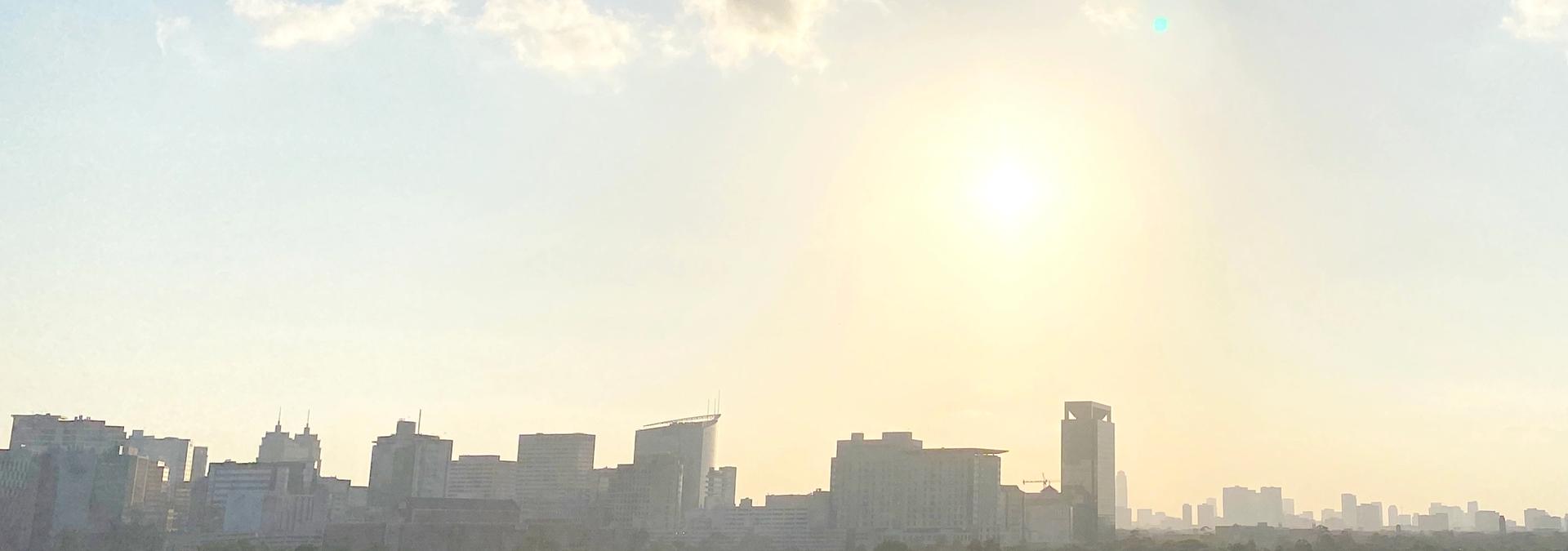
What is ozone?
Nitrogen oxide and volatile organic compounds emitted by cars, trucks, industrial facilities and other sources react together with sunlight to form ozone. Photo: Allyn West.
Ground-level ozone, or smog, is a lung-searing gas that forms when emissions from smokestacks and tailpipes cook in the heat and sunlight. These chemicals include volatile organic compounds (VOCs) and nitrogen oxides (NOx).
Houston, in particular, is a prodigious smog-making machine because of its commuting culture, heavy industry, busy port and climate. Ozone levels have dropped significantly in greater Houston since it surpassed Los Angeles as the nation's smog leader in the late 1990s, but the eight-county region still has a long way to go before its air meets health-based standards.
How is smog harmful?
Smog is a powerful oxidant that can irritate the airways, causing a burning sensation, coughing, wheezing and shortness of breath.
Scientists have linked smog to several health problems, including premature death, heart failure, increased hospital admissions, increased emergency room visits and possible long-term damage to the lungs.
Children, the elderly and people with existing respiratory conditions are the most at risk from smog pollution. Children are more vulnerable to the damaging effects of smog because their lungs are still developing — and they tend to be more active outdoors, even when smog levels are high. Studies have shown children with asthma are especially vulnerable to smog as are people engaged in vigorous outdoor activity.
“As a mother of an asthmatic son in Houston, I know he suffers most on high-pollution days,” said Catherine Flowers, field director for Moms Clean Air Force in Texas. “But there are thousands of children suffering from asthma in Houston. It’s why we need to strengthen, not weaken, our clean air protections.”
Ozone is a widespread problem in Houston
Houston has never met the Environmental Protection Agency’s health-based standards for ozone. The American Lung Association’s “State of the Air” report gave an “F” to Brazoria, Galveston, Harris and Montgomery counties for ozone once again this year. In the 21-year history of the report, greater Houston has never received a passing grade.
Clearly, the problem is not isolated to heavily industrial Houston Ship Channel: 36 of the eight-county region’s 41 stationary monitors have recorded days with unhealthy levels of smog. That includes monitors in Brazoria, Galveston and Montgomery counties, as well as southwest Harris County.
In 2019, Houston experienced 29 ozone action days — about a month, in all — when levels created air considered unhealthy, even dangerous, especially for sensitive groups.
Houston’s nine-month ozone season is longer than hurricane season. Rising temperatures and changing wind patterns exacerbate both seasons. “Ozone season grows longer every year with climate change,” said Rachel Fullmer, senior attorney with Environmental Defense Fund. “The hotter it is, the sunnier it is, the more likely it is that VOCs are going to react and form ground-level ozone. It’s a public health crisis that’s getting worse.”
What can we do about it?
Currently, the eight-county Houston region is in “nonattainment” with the National Ambient Air Quality standards, or NAAQs [say, “Nacks”] for ozone. Created under the Clean Air Act, the NAAQs set health-based standards and require metro areas to implement plans to improve the air quality if pollution levels exceed them.
The City of Houston recently announced a Climate Action Plan that outlines how it will achieve carbon neutrality by 2050. The plan focuses on reducing emissions from a range of sources, including transportation, which is responsible for a large share of the pollutants that form ozone. It accounts for two-thirds of NOx emissions and one-fourth of VOCs.
On ozone action days, residents are encouraged to take transit, bike and walk as much as possible. The city’s climate plan calls for investments in these options, as well as the retirement and replacement of Houston’s regional fleet of cars and trucks with low-emission and electric versions, both of which, with reducing vehicle miles traveled overall, would help reduce ozone.
And the plan comes just a few months after Houston’s METRONext was resoundingly approved by voters, which will expand transit options and take 500,000 cars off the road each day by 2040. These two initiatives, together, represent a good start.
Transportation is only part of the smog problem. Despite a 40 percent reduction in traffic during local orders to stay home to stop the spread of the coronavirus, air quality did not improve, a recent NPR analysis found. It is clear that Industry has an outsized role in determining air quality. Houston’s petrochemical facilities are responsible for emitting, often illegally, thousands of pounds of dangerous chemicals each year.
Houstonians agree that government at all levels must do more to control pollution, with more respondents to the 2020 Kinder Houston Area Survey rating the control of air pollution “poor” than in the past decade. “There are many common-sense solutions for reducing ground-level ozone formation and protecting public health, such as reducing the precursor emissions from the oil and gas sector and other industrial sources,” Fullmer said.
Implementing those solutions and bringing the Climate Action Plan into reality will help to address Houston’s smog problem and ensure clean air for everyone.
Fraser is a clean air associate with Environment Texas.
STAY UP TO DATE
The quality of our newsletter is considered satisfactory and poses little or no risk.
SUBSCRIBE

